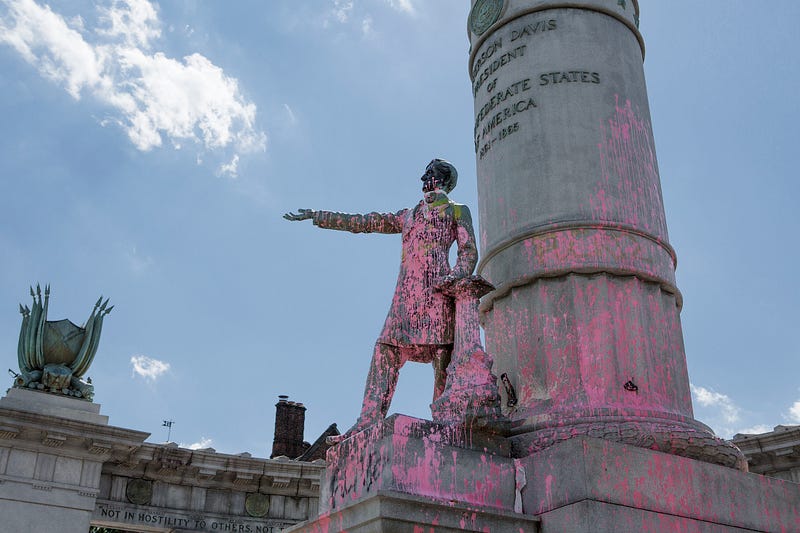The BLM movement is writ large on the Civil War monuments of the Confederacy’s former capital. And now some controversial statues are being removed.

Broad Street’s home is in Richmond, Virginia, where Jefferson Davis once presided over the rebel would-be nation in what’s known as the White House of the Confederacy — a scant block away from the city’s own Broad Street, in fact.

Richmond is also known for Monument Avenue, conceived as part of a movement to create “grand avenues” of stately homes and tree-lined medians throughout the United States in the early 1900s. The street gets its name and character from a series of bronze statues celebrating famous men of the Confederacy.
After the brutal deaths of George Floyd and Breonna Taylor, Monument Avenue has become one of the arteries for protest in the South. The Confederate statues have been covered in graffiti, and people of all races have been gathering around them to stand in solidarity to the Black Lives Matter movement and to learn about racism in the U.S. The Avenue has become a site of outright and very visible protest — Richmond’s Berlin Wall, maybe also the nation’s, dividing the citizenry. And like the Berlin Wall, it is coming down.
John Moser documented the peaceful daytime activity of the protesters on June 8, 2020. He says, “I’ve been working to get these monuments removed since about 2014, and I’m glad this is happening. The outpouring of emotion from the community has surprised me, though. Anyone who has the chance should try to see Monument Avenue right now.”
Six statues extend about two miles down the wide avenue, standing at major intersections. Most of the monuments celebrate men who had an impact on the Civil War: Robert E. Lee,whose statue went up in 1890, General J.E.B. Stuart (1907), Jefferson Davis (1907), Stonewall Jackson (1919), and oceanographer and mapmaker Matthew Fontaine Maury (1929). Tennis player and social activist Arthur Ashe finishes the grand part of the street (1996). His placement at the end of the line of slaveowners has long been controversial.

For the last twenty years and more, many Richmonders, of all races, have advocated for the removal of the Confederate monuments. Now the major monuments, and the Civil War cannons that dot the median, have been graffitied. The graffiti demands the statues’ removal. It screams anguish — “F12,” “Our Blood Built This Country,” “End Trump” — but also declares “Love Will Win.”
Protesters are peaceful, holding signs and talking with others who have come to be educated. They pose on the monuments’ pedestals en pointe in ballet shoes or with children strapped to their backs, wearing masks against Covid-19. They are Black, yes, and also white and every other race in Richmond.

“You have to be there to see the reactions of the steady stream of people who visit,” says John. “There’s dancing, tears of joy [because the movement is gaining traction], singing, and most of all — it’s great to see all the very young folks expressing self-confidence while honoring their ancestors and their identity.”

The graffiti has made these public monuments into a different kind of art, and one that many people are now saying should be preserved in its own right. It’s painful. It’s beautiful. It turns around the brutal inscriptions that went up with the original monuments.

Soon, the monuments themselves will be gone — or at least that’s the plan. The Lee statue could disappear within the week; it stands on state-owned land and required a special legal dispensation for removal. The others are also scheduled to go, perhaps to a museum, perhaps just into storage.
Jefferson Davis (immediately above and to the left) came off his pedestal on the night of June 10–11, to cheering from a small crowd of midnight onlookers.
Is a total removal of the Confederate statues possible? The Monument Avenue Preservation Society has been attempting to block the action, arguing that the statues are artworks. To many people, Avenue is a sort of sculpture garden in which the statues have not only historical significance but aesthetic importance in their own right.
“It’s something I’ve thought about a lot,” John says. “I think it’s a good idea for this particular art show to go to another ‘gallery.’ No need to destroy the sculptures. I’m sorry that some folks will miss them when they’re gone, and if what we have now is replaced by something commonplace, I’ll also be surprised, because I think the gallery will eventually have another show.”

He sees the graffiti, protests, and removals as a good sign: “I grew up here. By the time I was twelve, I started to get the idea that Richmond might never get out from under the shadow of the Confederacy. That was fifty-three years ago, and those statues are still there, casting big shadows. I’ll be very happy if this city can move toward releasing itself from the death grip of the Confederacy, finally, and I see this [protest] as a step in that direction.”

***********************************************************************

John Moser is a visual artist, musician, and designer who has several careers as a jack-of-all-arts. He has designed and built interactive exhibit environments for the past twenty years, interpreting science and history subjects ranging from radio astronomy to Powhatan Indian culture for museum audiences. Photography is a major component of the work he does for his clients, for art exhibitions, and to share on social media. His work was featured previously in our “Bedeviled” issue.








